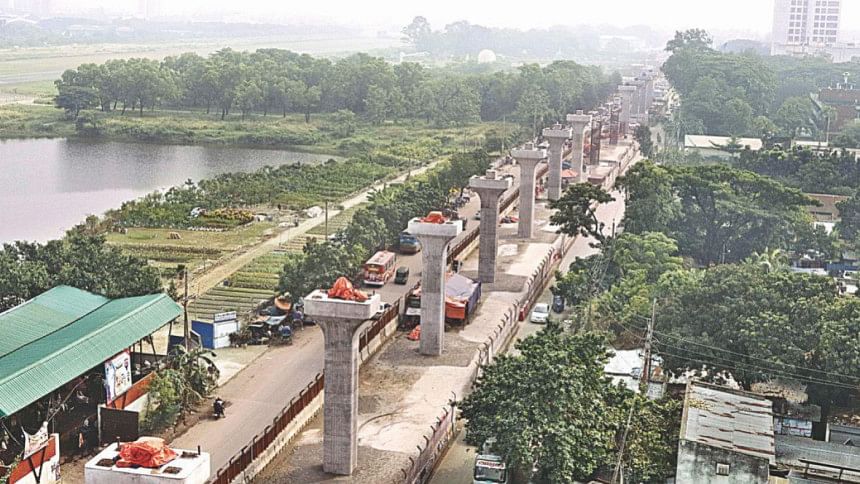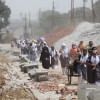Striking a balance between development and environment

"Only when the last tree has been cut down, the last fish been caught, and the last stream poisoned, will we realise we cannot eat money." Cree Indian Prophecy
Just as a country's development cannot be sustainable without a properly functioning democracy, development without environmental protection is also bound to fail. While Bangladesh is advancing with its various development projects at a fast pace, the issue of protecting the environment has taken a back seat in the process. We have already witnessed the negative impacts of unbridled polluting of our environment in the name of urbanisation, industrialisation, and development. Thus the question is, will all the development activities currently going on in the country be sustainable in the long run?
Bangladesh has achieved remarkable economic success in the last few decades. It has been transitioning from being one of the least developed countries to a developing one. According to IMF, Bangladesh is among the three fastest growing economies in the world. As per the IMF report "World Economic Outlook, April 2019: Growth Slowdown, Precarious Recovery," Bangladesh's economy will grow at 7.3 percent this year. And the World Bank has put Bangladesh in the 5th position in the world in terms of economic growth. The World Bank in its report said, "this growth was caused by manufacturing, construction and a bumper crop harvest, coupled with private consumption, remittance and rural income growth." All these are very positive news. But for sustainable economic development, we need to give the issue of environmental protection the attention it deserves.
While praising its different development activities, the government always cites the examples of the two Southeast Asian countries—Malaysia and Singapore. They are our role models for development. Let's put aside the debate on whether the development models of Malaysia or Singapore can be applied here. These two countries are also not the best examples of democracy. But in terms of economic growth and development, they have achieved tremendous success. Thus, if we have to follow the path to Malaysia's development, we also need to know how the country is doing in terms of protecting its environment.
Malaysia's economy is the third largest in Southeast Asia. The country's position in terms of Gross Domestic Product per capita is the fifth highest trailing behind the four Asian Tigers—South Korea, Taiwan, Singapore, and Hong Kong. According to the Global Competitiveness Report 2018, Malaysia was the 25th most competitive country in the world in the period of 2018-19. Malaysia's economic transition began in the 1970s, when its economy was based on mining and agriculture. Since the 1980s the industrial sector has led Malaysia's growth. the country underwent rapid development during the late 20th century. Currently, less than one percent of Malaysian households live in extreme poverty. According to the World Bank, the country is expected to achieve its transition from an upper middle-income economy to a high-income economy by 2024.
Although rapid industrialisation and urbanisation in Malaysia has had its impact on the environment, the country has taken the issue of environmental protection quite seriously. Malaysia still has 62.3 percent forest coverage, according to FAO. It is recognised as one of the top 12 countries for mega-biodiversity and ranked fourth in the world for having the most tree species. The country has formulated several laws for river protection, forest conservation and improvement of air quality.
Compared to Malaysia, what we see in Bangladesh is a complete disregard for the environment. Unplanned urbanisation and industrialisation have taken its toll on our rivers and water bodies—pollution and grabbing have led to the death of many rivers. The four rivers—Buriganga, Sitalakhaya, Turag and Balu—surrounding our capital have become extremely polluted because of unplanned industrialisation. Industrial wastes have polluted the Buriganga so much that its water is not drinkable even after treatment.
Bangladesh currently has only 13 percent forest coverage, according to FAO estimation. The coverage is supposed to be 25 percent for a proper ecological balance. Yet, we are constructing the Rampal power plant near the Sundarbans, without considering the devastating impacts it will have on the world's largest mangrove forest. The work for the Rooppur nuclear power plant has also started. Besides, our precious forestland has been used for various government and non-government projects.
A recent global survey on air quality has found that Bangladesh's air is the most polluted in the world. Indoor and outdoor air pollution led to 1.23 lakh deaths in Bangladesh in 2017, according to The State of Global Air 2019 report. Yet, illegally constructed brick kilns, which are the major polluters of our air, as found by the DoE, are emitting black smoke and big infrastructure projects and other construction works go on without taking any precautions for environmental safety.
What is the point of our economic growth and so-called development, if the fruits of development do not reach the general people, but rather causes more suffering for them? What is the point of building all the flyovers in Dhaka if they serve only eight percent of the city's people? What is the point of building the Rampal power plant if it jeopardises the environment and people's livelihoods?
While we want to imitate Malaysia in terms of development, we should also look to how they are handling their environmental issues. Unsurprisingly, Malaysia has also been facing some environmental problems because of rapid industrialisation. According to the New Strait Times, between 2009 and October, 2017, there were 149 cases of oil-spills in Malaysian waters (November 9, 2017). Being one of the world's biggest plastic importers, plastic pollution is a big environmental threat to the country. Besides, illegal waste dumping takes place in many parts of Malaysia. In March this year, around 20 to 40 tonnes of chemical waste were illegally dumped into parts of the Sungai Kim Kim river in the Pasir Gudang industrial town in Johor state in southern Malaysia. The disaster has been ranked among the country's worst environmental calamities in living memory, with more than 3,555 people affected and 111 schools in the district remaining closed for several days. But timely intervention by the local authorities brought the situation under control.
In the aftermath of such disasters, the Malaysian government has decided to strengthen its environmental laws. The Malaysian Prime Minister Dr Mahathir Mohamad has expressed his thoughts on the importance of preserving the environment. He said, "We need to realise that our efforts to become a developed nation will not be achieved or recognised, if what we can show is only skyscrapers but our rivers are polluted, only barren land is left out of our wilderness and the air we breathe is badly polluted."
Mahathir's words can be a lesson for us too. Because for Bangladesh, coping with the environmental impacts of rapid urbanisation, unplanned industrialisation and indiscriminate development programmes remain a major challenge. We should not allow the destruction of environment in the name of development. We should remember that development is meant to improve our standard of living and it should never be prioritised over the environment.
Naznin Tithi is a member of the editorial team at The Daily Star.

 For all latest news, follow The Daily Star's Google News channel.
For all latest news, follow The Daily Star's Google News channel. 





Comments